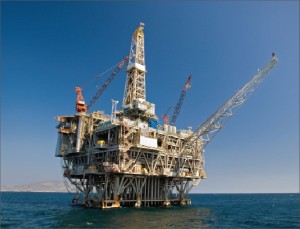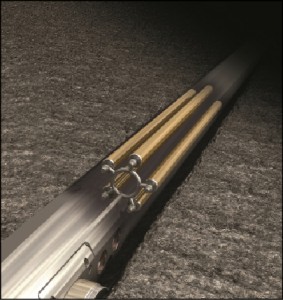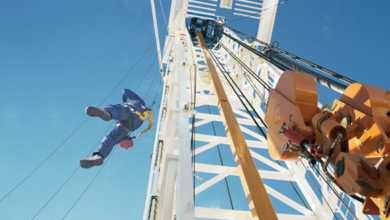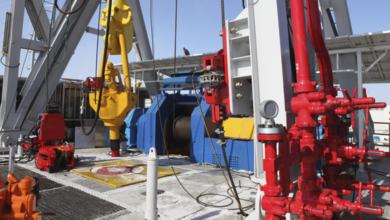D&C Tech Digest

ExxonMobil completes world’s longest ERD well from fixed platform offshore California
ExxonMobil has completed the world’s longest extended-reach well drilled from an existing offshore fixed platform drilling rig, increasing the company’s ability to produce oil from existing facilities at the Santa Ynez unit, offshore southern California. The well, drilled from the Heritage platform using ExxonMobil’s Fast Drill technology, extends more than six miles horizontally and more than 7,000 ft below sea level.
Through the use of the extended-reach technology, the well will be able to produce an additional 5.8 million bbl of oil equivalent. “These new tools and lessons learned from our recent work off Russia’s Sakhalin Island have been key in helping us reach these resources safely and efficiently,” said Kok-Yew See, US production manager.
The Hondo, Harmony and Heritage platforms comprise the Santa Ynez Unit and produce oil and gas from the Hondo, Pescado and Sacate fields. Since 1981, the Santa Ynez Unit has produced more than 450 million bbl of oil.
ExxonMobil’s extended-reach drilling technology has allowed oil production in the western Sacate field from the existing offshore Heritage platform since 2007. The company is also applying its Fast Drill technology to achieve improvements in drilling rates of up to 80%.
Reaming system allows open-hole liner placement
Aberdeen-based Deep Casing Tools has successfully run its new well reaming system, Turborunner, in the central North Sea, UK, for PetroCanada. The operator selected the system for a horizontal application in the Saxon development well 21/23b-S2. A 3,000-ft pre-drilled liner was placed from a semisubmersible. The tool is designed to enable open-hole completion placement operations. It combines optimized washing with a rotational reaming capability without the need to rotate the completion string. It has a low operating pressure, allowing integration with most completion systems.
Large microseismic hydraulic fracturing monitoring surveys finished in Canada
Baker Hughes and VSFusion, a borehole seismic processing joint venture between Baker Hughes and CGGVeritas, recently completed one of the largest microseismic hydraulic fracture monitoring surveys ever undertaken. The survey for Apache Canada in the Horn River Basin of northwest Canada deployed Baker Hughes’ geophone strings simultaneously in two observation wells for over 30 days. Microseismic events were recorded for hydraulic stimulations in 13 wellbores adjacent to the observation wells. In all, over 75 separate hydraulic stimulations were recorded.
The project used a variety of deployment geometries in both the horizontal and near-vertical sections of the observation wells to optimize hydraulic fracture imaging in the reservoir. Operations were conducted 24 hrs/day, and VSFusion provided real-time display of recorded microseismic events, both on the well site and in Apache’s offices in Calgary and Houston. Monitoring and analysis of microseismic information during operations allows optimization of the hydraulic stimulation process by modifying the fracture stage design while pumping into the formation.
Apache used the data to experiment with how different perforation patterns impacted fracture propagation, then made real-time changes in the fracture program. At one point, data showed an absence of growing microseismic activity, alerting Apache to switch from pumping proppant to flushing the well with water to avoid a potentially costly sanding-off of the fractures.
Recording microseismic events to monitor rock fracturing in 3-D space and time during the stimulation process confirms the rock volume and formation geometry being stimulated. This can optimize future well placement and completion designs.

Sampling-while-drilling sensor tested offshore Norway for BG Norge
Halliburton recently completed field tests for the GeoTap IDS fluid identification and sampling sensor for BG Norge. The test was performed on the Bredford Dolphin drilling rig for the 34/5-1 S Blåbær exploration well offshore Norway. Application of the technology saved rig costs and reduced the requirement for post-well wireline sampling.
Using the new sensor, reservoir formation fluids can be sampled during short stops in the drilling process with a tool placed in the logging-while-drilling (LWD) assembly. This makes the technology ideal for high-cost drilling environments. The sensor also allows operators to acquire multiple fluid samples within just hours of drilling the formation instead of days, reducing the likelihood of borehole damage and producing a less contaminated sample.
By allowing several samples to be collected through a productive hydrocarbon zone during pauses in the drilling operation, the tool improves operators’ ability to quickly characterize fluid variability, often an indicator of reservoir compartmentalization. The tool also has the potential to optimize wellbore placement and achieve maximum production over the life of the reservoir.
Linear biopolymer used as alternative to xanthan gum viscosifiers in Alaskan well
M-I SWACO’s POWERVIS linear biopolymer, the new viscosifier used in FLOPRO reservoir drill-in fluid systems, enabled an operator in Alaska to drill a high-angle, extended-reach, slim-hole, coiled-tubing drilling (CTD) sidetrack while minimizing pressure loss and elevating low shear-rate viscosities. The biopolymer exhibited 10% to 22% lower operating system pressure loss and, compared with a xanthan gum biopolymer, it reduced ECD by 0.8 lb/gal EMW, said M-I SWACO project engineer Rick Morris.
Previous long-reach wells in the area experienced high ECD and system pressure losses of up to 4,000 psi. The FLOPRO SF reservoir drill-in fluid with a xanthan gum biopolymer had been used as the system viscosifier in previous sections, but, due to the nature of this section, the POWERVIS linear biopolymer was selected.
The initial comparative free-spin pressure loss was 650 psi lower than the xanthan gum system. When the agitator tool was added to drillstring in the remaining 500 ft (152 m) of the lateral section, the initial free-spin pump pressure was 2,800 psi, approximately 700 psi lower than that of the standard FLOPRO SF RDF system viscosified with xanthan gum.
When it is employed, the agitator tool alone will add 500 psi to the overall system pressure loss. POWERVIS is a rheology-modifying agent used to provide viscosity and solids suspension in FLOPRO SF and FLOPRO CT systems. It can be used as a viscosifier in a FLOPRO NT system using fresh water or low-salinity chloride brines.
HPHT suite helps re-entry on Davy Jones well
Baker Hughes has successfully deployed a suite of technologies for high-pressure, high-temperature (HPHT) environments at the McMoRan Exploration Davy Jones ultra-deep gas discovery in 20 ft of water on the shelf in the Gulf of Mexico.
The technology was used to re-enter an existing well, set a whipstock at approximately 17,300 ft and drill to over 29,000 ft MD in the extreme HPHT conditions of the Gulf of Mexico shelf Lower Tertiary formations. Challenges encountered during the operation ranged from executing a reliable sidetrack, improving well stability, designing a robust and reliable drilling system to withstand the extreme pressures and temperatures, and obtaining logging data in this difficult downhole environment.
The wireline logging operation was particularly critical in providing additional reservoir understanding. The Nautilus Ultra suite of logging tools, rated to 30,000 psi and 500°F, were used. This included acoustic pipe-conveyed logging tools for HPHT environments. Logging operations were conducted at 28,134 ft and included acoustic, gamma ray, density and neutron logs. During the drilling and formation evaluation operation, McMoRan experienced no nonproductive time due to whipstock, drill bit, drilling fluids or liner hanger operations conducted by Baker Hughes.
Separately, Baker Hughes has successfully field-tested the industry’s first large-diameter sidewall coring tool offshore Brazil. The MaxCOR rotary sidewall coring tool was developed in response to an operator’s request for 1.5-in. diameter core samples greater than 2 in. in length. During the first test, the client requested 90 cores throughout the reservoir. The tool recovered 94 cores in four runs. In another test, the tool was deployed to successfully complete a 54-core program in two runs.
MaxCOR can recover large-diameter core samples after a well is drilled to cover intervals either not cored with conventional coring operations or where conventional coring operations did not achieve 100% recovery.



